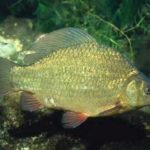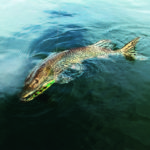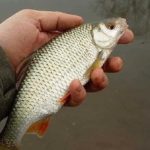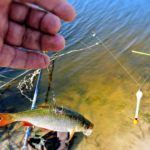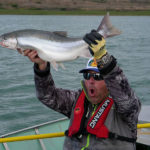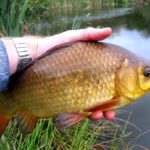Fly Rod – how to choose?
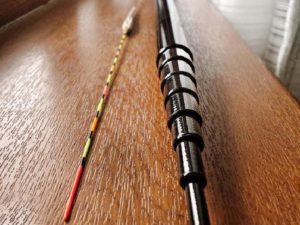 Information on modern fly fishing rod in the “sports – advertising” fishing publications is somewhat one-sided, they say, there are “good” carbon fiber rods, and there are “bad” fiberglass rods. In this regard, the beginner lover is really difficult to figure out – how to choose a fly fishing rod? And even more so what should be her equipment. Unlike advertising brochures, in real catching the picture is much more complicated, and you choose fishing rods for your technique and fishing tactics, to the size of a fish, so you would break the float rods without rings into two types.
Information on modern fly fishing rod in the “sports – advertising” fishing publications is somewhat one-sided, they say, there are “good” carbon fiber rods, and there are “bad” fiberglass rods. In this regard, the beginner lover is really difficult to figure out – how to choose a fly fishing rod? And even more so what should be her equipment. Unlike advertising brochures, in real catching the picture is much more complicated, and you choose fishing rods for your technique and fishing tactics, to the size of a fish, so you would break the float rods without rings into two types.
The first would carry fishing rods for bottom fishing. On the river, it is such a popular and effective “half-brat”, and in still water at the bottom – so often carp, bream, and small carp are caught. The fish approaches the coastal grass, where they lie in wait and wait. For such a catch, “frail” thin-walled coal rods are completely unsuitable, and I choose the most durable, reliable fiberglass. And their relatively large weight does not play any role, because the rod from cast to bite lies on the stand. At the same time, “glass” fishing rods are very strong, and as you will find them in the fight against large fish on a short fishing line.
The second type would include the rest of the fishing rods, designed for active fly fishing, when the equipment is already delicate, the rod is always in hand, constantly toss portions of bait and, as a pioneer, always ready to hook up or reset the equipment. I agree that for such a fishing a good carbon-fiber rod is good, but this characteristic doesn’t say anything, because there is a “theory”, but there are real fishing rods in the store and real fishing.
Light is heavy. In the shops you can run into cheap, very light coal rods – the “five” can weigh no more than 100 grams, but such a flimsy “Chinese” can easily break on a two hundred gram perch or a bream grams under 300. Often the fishermen reproach – they say, you have to catch neat, but it’s all bullshit! If the rod breaks simply from a sharp swing against the wind, otherwise you will not abandon the lightweight snap, then the price is such a catch. One familiar fisherman involved in the repair of rods, said that such “Chinese” have very thin walls – so the fishing rod and light and low-quality binders, fastening carbon fiber – hence the frequent breakdowns. Moreover, many light fishing rods of already famous “offices” are also not strong enough, the laws of physics cannot be fooled – the lightest rods are always less strong. Therefore, I believe that the choice of the lightest fishing rod is the wrong one, if active fishing is planned – moreover a running gear, and even on the bushes – fish of decent size.
It is said that expensive light fishing poles are designed for “experienced athletes who have extensive experience in dealing with large fish on a thin fishing line. I would call it a different way: accurate haul-off of small fish weighing 100 – 200g with an obligatory pumping of each tail. To whom this is to your liking – please, but I prefer to force a kilogram bream evenly out of force – to the point of strength of the leash, knowing at the same time that the rod can bring. Why do you need this?
On the other hand, the heaviest rod – usually a composite – “mash” of a large amount of glass and coal, also does not give pleasure from catching, despite one hundred percent reliability. Therefore, I personally am for the “average” weight variant and, accordingly, for the “average” price. Of course, the weight of the fishing rod depends directly on the brand of graphite. After all, the wall thickness can be the same, while the weight decreases, but these pleasant changes will certainly raise the price of the fishing rod.
And about weight: I noticed that two rods in the assembled state can be of the same weight. And if you decompose them, you may feel that one is heavier than the other. Looking closely, you understand that the more “heavy” center of gravity is simply shifted to the vershinka due to heavier middle knees and relief of the upper ones. Apparently, with this method, which unbalances the bait, put the counterweight in the knee, the manufacturer is trying to improve the system.
Of course, from the point of view of an advanced spinningist, such a notion as a system in a float rod sounds almost a curse – what could be a line of fishing rods 4-5m long, especially 6-7m ?! Nevertheless, I think that when choosing a fishing rod, one cannot do without such characteristics – like a rigid rod, a soft one or some kind of intermediate option. Build a float simply to determine if this concept is equated simply to the curve of bending under load. A rigid rod bends the tip and one knee following it. A soft rod is characterized by a significantly larger length that bends under a load. Soft fishing rods perfectly throw light equipment with small floats.
Hard rods, of course, also have their own advantages: they allow you to make short hooks with jewelry, which keep a thin leash, and make it possible to increase the speed of catching small things – you can easily pull out of the water from the water with a soft fishing rod.
